engine MAZDA 232 1990 Workshop Manual Suplement
[x] Cancel search | Manufacturer: MAZDA, Model Year: 1990, Model line: 232, Model: MAZDA 232 1990Pages: 677, PDF Size: 61.19 MB
Page 5 of 677
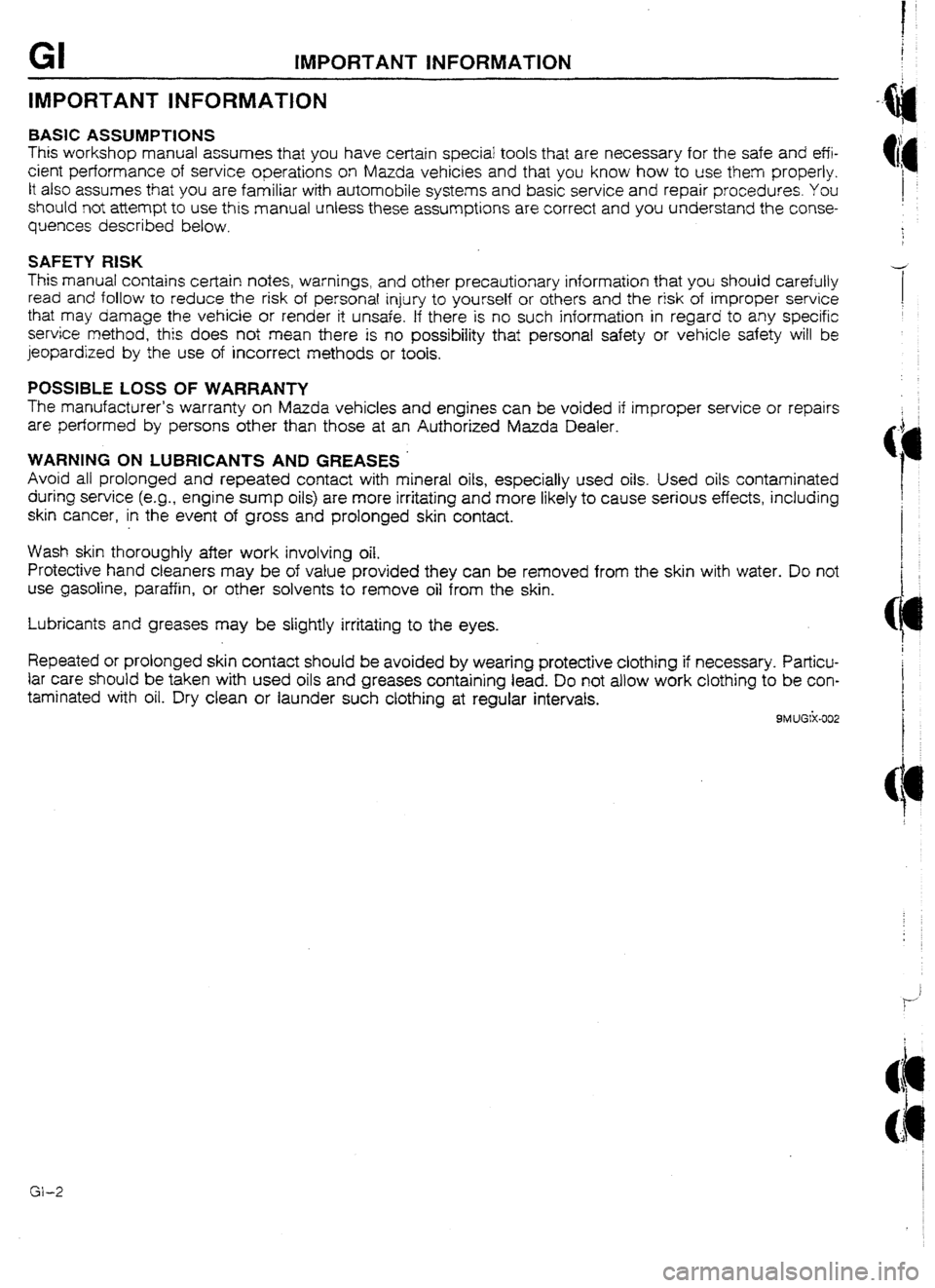
GI IMPORTANT tNFORMATlUN
IMPORTANT INFORMATION
1
.ftl
1
BASIC ASSUMPTIONS
This workshop manual assumes that you have certain special tools that are necessary for the safe and effi-
cient performance of service operations on Mazda vehicles and that you know how to use
them properly.
It also assumes that you are familiar with automobile
systems and basic service and repair procedures. You
should
not attempt to use this manual unless these assumptions are correct and you understand the conse-
quences described below.
SAFETY RlSK
This manual contains certain notes, warnings, and other precautionary information that you should carefully
read and follow to reduce the risk of personal injury to yourself or others and the risk of improper service
that may damage the vehicle
or render it unsafe. If there is no such information in regard to any specific
service method, this does not mean there is no possibility that personal safety or vehicle safety will be
jeopardized by the use of incorrect methods or toots.
POSSIBLE LOSS OF WARRANTY
The manufacturer’s warranty on Mazda vehicles and engines can be voided if improper service or repairs
are performed by persons other than those at an Authorized Mazda Dealer.
WARNING ON LUBRICANTS AND GREASES ’
Avoid all prolonged and repeated contact with mineral oils, especially used oils. Used 08s contaminated
during service (e.g., engine sump oils) are more irritating and more likely to cause serious effects, including
skin cancer, in the event of gross and prolonged skin contact.
Wash skin thoroughly after work involving oil.
Protective hand cleaners may be of value provided they can be removed from the skin with water. Do not
use gasoline, paraffin, or other solvents to remove oil from the skin.
Lubricants and greases may be slightly irritating to the eyes.
Repeated or prolonged skin contact should be avoided by wearing protective clothing if necessary. Particu-
lar care should be taken with used oils and greases containing lead. Do not allow work clothing to be con-
taminated with oil. Dry clean or launder such clothing at regular intervafs.
9MUGiX-502
Page 7 of 677
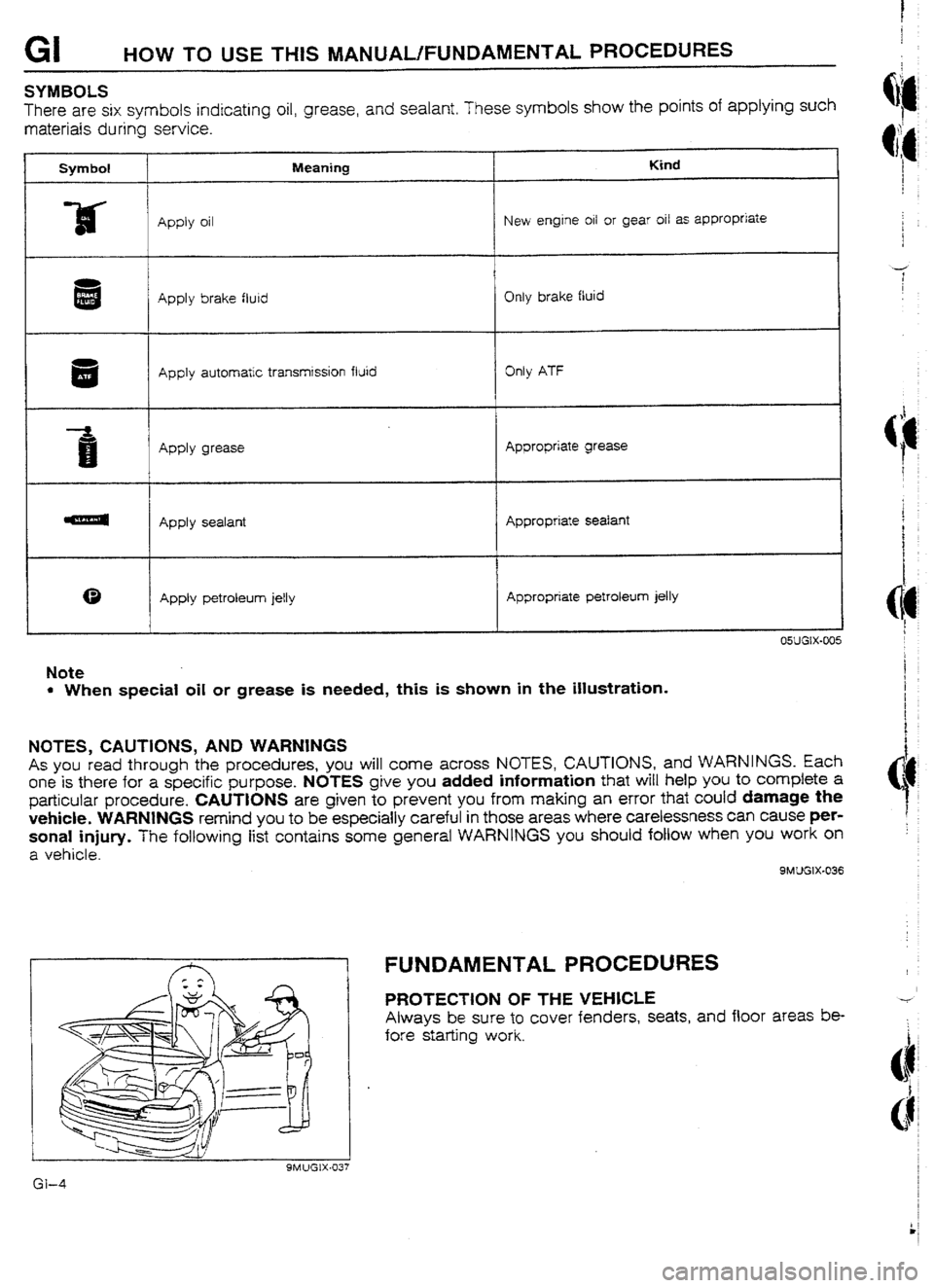
GI HOW TO USE -MS lVlANUAL/FUNDAMENTAL PROCEDURES
SYMBOLS
There are six symbols indicating oil, grease, and sealant.
These symbols show the points of applying such
materials during service.
Symbol
It Meaning Kind
I
Apply oil New engine
oil or gear oil as appropriate
Apply brake fluid Only brake fluid
Apply automatic
transmission fluid
Apply grease Only ATF
Appropriate grease
Appty sealant Appropriate sealant
m
0 Apply petroleum jelty Appropriate petroleum jelly
Note
l When special oil or grease is needed, this is shown in the illustration.
NOTES, CAUTIONS, AND WARNINGS
As you read through the procedures, you will come across NOTES, CAUTIONS, and WARNINGS. Each
one is there for a specific purpose. NOTES give you added information that will help you to complete a
particular procedure. CAUTlUNS are given to prevent you from making an error that could damage the
vehicle. WARNINGS remind you to be especially careful in those areas where carelessness can cause per-
sona! injury. The foliowing list contains some general WARNINGS you should follow when you work on
a vehicle.
9MUGlX-036
FUNDAMENTAL PROCEDURES
PROTECTON OF THE VEHICLE
Always be sure to cover fenders, seats, and floor areas be-
fore starting work.
Page 8 of 677
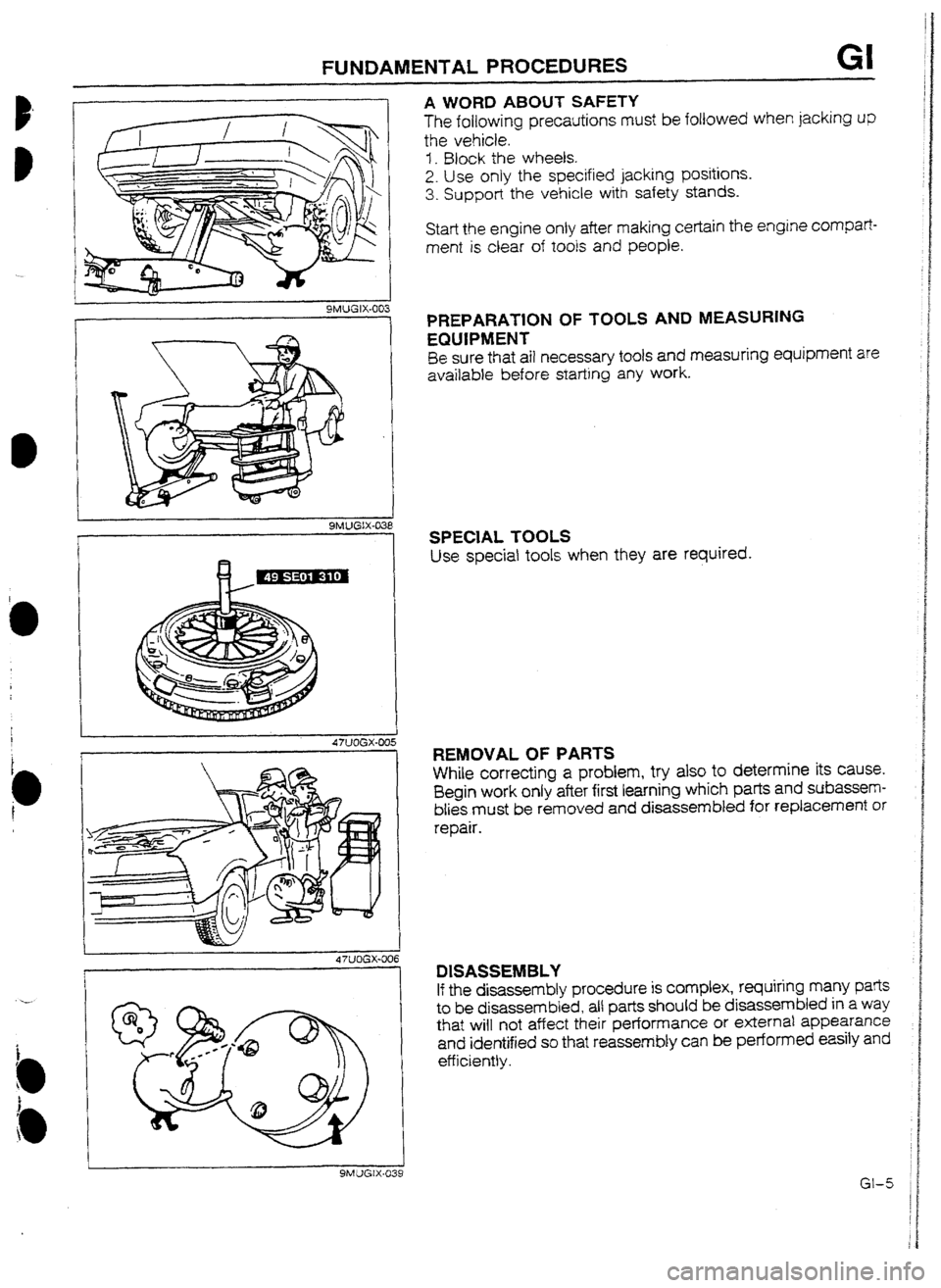
FUNDAMENTAL PROCEDURES GI
I 9MUGIX-003
I
SMUGIX-038
A WORD ABOUT SAFETY
The following precautions must be followed when jacking up
the vehicle,
3. Block the wheels.
2. Use only the specified jacking positions.
3. Support the vehicle with safety stands.
Start the engine only after making certain the engine compart-
ment is clear of tools and people.
PREPARATION OF TOOLS AND MEASURING
EQUIPMENT
Be sure that all necessary tools and measuring equipment are
available before starting any work.
SPECIAL TOOLS
Use special toots when they are required.
REMOVAL OF PARTS
White correcting a problem, try also to determine its cause.
Begin work only after first learning which parts and subassem-
blies must be removed and disassembled for replacement or
repair.
1 47ilOGX-006
1 DISASSEMBLY
If the disassembly procedure is complex, requiring many parts
to be disassembled, all parts should be disassembled in a way
that will not affect their performance or external appearance
and identified so that reassembly can be performed easily and
efficiently.
t
9MlJGIX439
Page 13 of 677
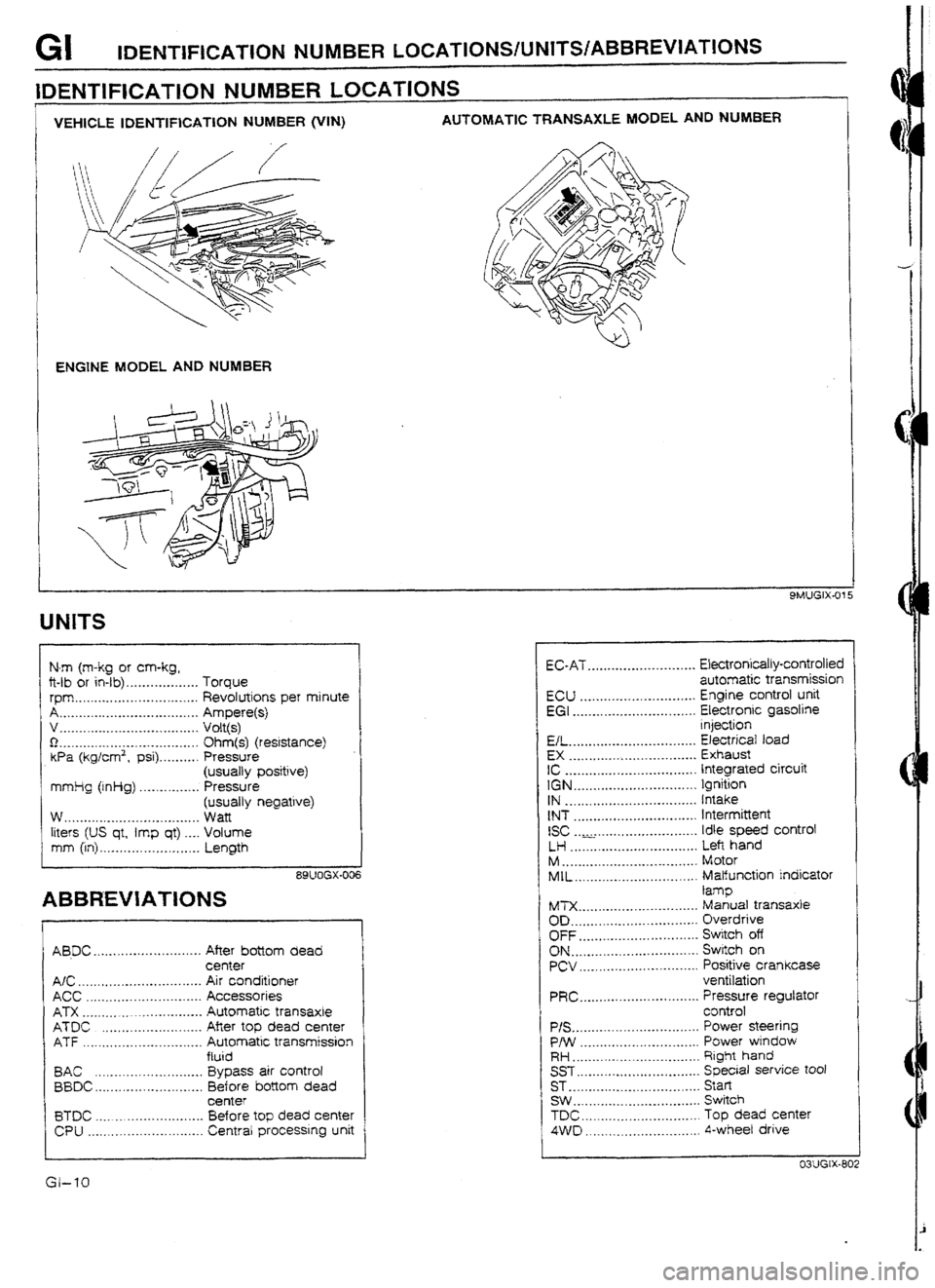
GI IDENTIFICATION NUMBER LOCATIONSIUNITSIABBREVlATlONS
IDENTIFICATCON NUMBER LOCATIONS
I
VEHKZLE IDENTIFICATION NUMBER @‘IN) AUTOMATIC TRANSAXLE MODEL AND NUM8ER
ENGINE MODEL AND NUMBER
UNlTS
N-m (m-kg or cm-kg,
ft-lb or in-lb) . . . . . .._.......... Torque
rpm ._._..._.. . . . . . . .._.._.._. . .._. Revolutions per minute
A . . .._._._...__.._.._.._. .__...._. . . Ampere(s)
v .._.... .* .*... ..__.._...*. ..*. .*. ,. Volt(s)
0 I.._._............**..-.-*..-....... Ohm(s) (resistance)
Wa (kg/cm2, psi) . . . . . . . . . . Pressure
(usually positive)
mmlig (inHg) . . . . . . .._.._... Pressure
(usually negative)
w . . . ..*.....e*.-..-..-.....*.e..... Watt
liters (US qt, imp qt) .._. Volume
mm (in) ,_._.._._..._.,_. .~. . ..__ Length
89UOGX-006
ABBREVIATIONS
AB.DC ........................... After bottom dead
center
A/C _ .............................. Air conditioner
ACC ............................. Accessories
ATX ............................. Automatic transaxte
ATDC ......................... Afier top dead center
ATF .............................. Automatic transmission
ftuid
BAC ........................... Bypass air control
BBDC.. ......................... Before bottom dead
center
BTDC ........................... Before top dead center
CPU ............................. Central processing unit t EC-AT ........................... Ekctronically-controlled
automatic transmission
ECU ............................. Engine control unit
EGI ............................... Electronic gasotine
injection
EL ................................ Electricaf toad
EX ................................ Exhaust
IC ................................. Integrated circuit
IGN ............................... Ignition
IN ................................. Intake
tNT ............................... Intermittent
ISC ............................. Idle speed control
LH ................................ Left hand
M .................................. Motor
MIL ............................... Malfunction indicator
lamp
tb4TX. ............................. Manual transaxle
OD. ............................... Overdrive
OFF .............................. Switch off
ON ................................ Switch on PCV .............................. Positive crankcase
ventilation
PRC.. ............................ Pressure regulator
control
P/S ................................ Power steering
P/W .............................. Power wtndow
RH.. .............................. Right hand
SST ............................... Special service tool
ST .................................
Start
SW . . .............................. Switch
TDC. ............................. Top dead center
4VVD ............................. 4-wheel drive
Page 14 of 677
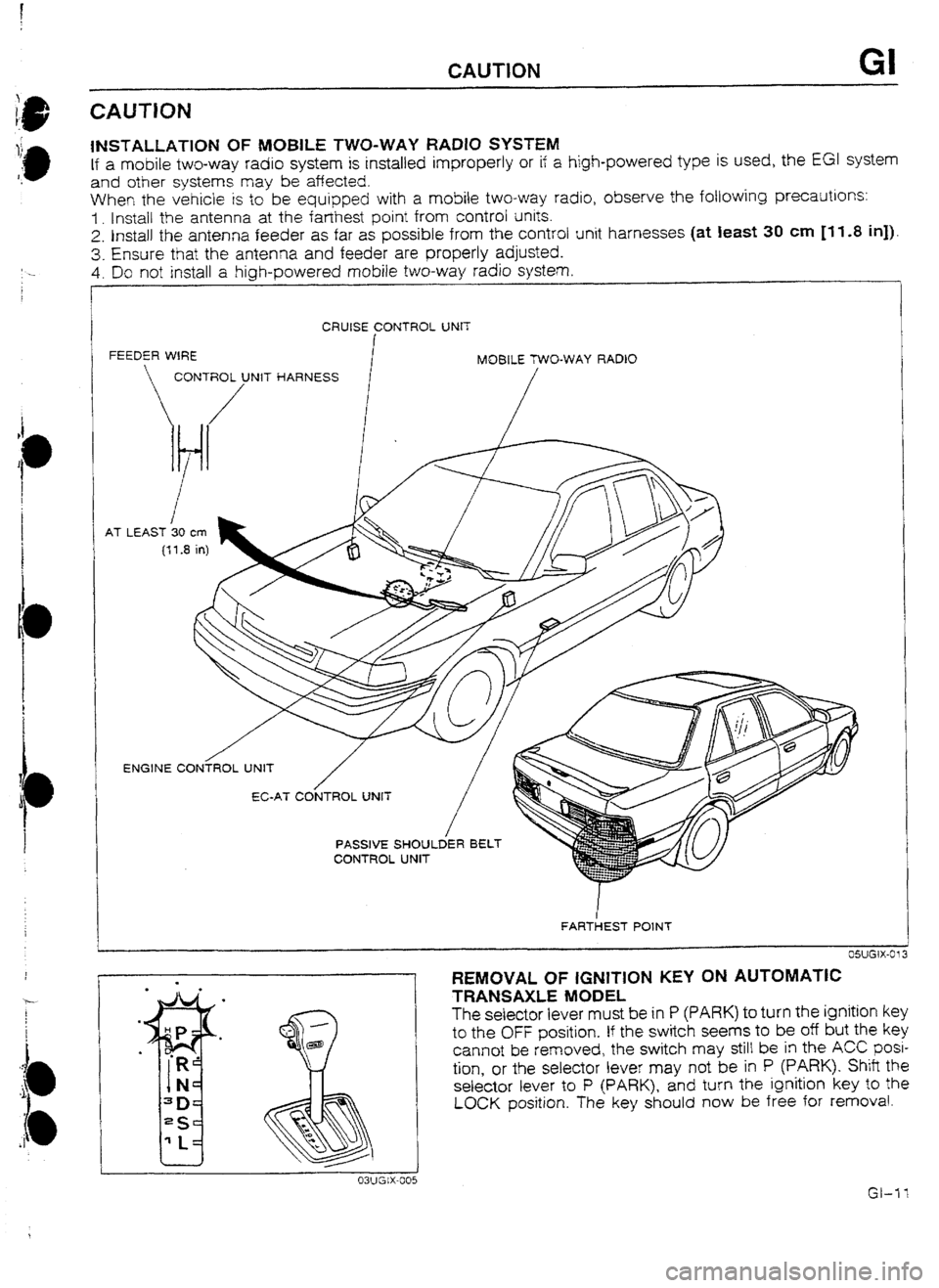
INSTALLATION OF MUBlLE TWO-WAY RADIO SYSTEM
If a mobile two-way radio system is installed improperly or if a high-powered type is used, the EGl system
and other systems may be affected.
When the vehicle is to be equipped with a mobile two-way radio, observe the fotlowing precautions:
I. Install the antenna at the farthest point from control units.
2. Install the antenna feeder as far as possible from the control unit harnesses (at Ieast 30 cm Ill.8 in]).
3. Ensure that the antenna and feeder are properly adjusted.
4. Do not install a high-powered mobile two-way radio system
r
CAUTION GI
i
CRUISE CONTROL UNIT
FEEDER WIRE
MOBILE TWO-WAY RADlO
CONTROt/UNlT HARNESS
/
AT . LEAST 30 cm
(f1.3 in)
ENGINE C0NiROL UNIT
/
FAR&T POlNT
REMOVAL OF IGNITION KEY ON AUTOMATIC
TRANSAXLE MODEL
The seiector iever must be in P (PARK) to turn the
ignition key
to the OFF position. If the switch seems to be off but the key
cannot be removed, the switch may stilt be in the ACC posi-
tion, or the selector lever may not be in P (PARK). Shitt the
selector lever to P (PARK), and turn the ignition key to the
LOCK position. The key should now be free for removal.
Page 21 of 677
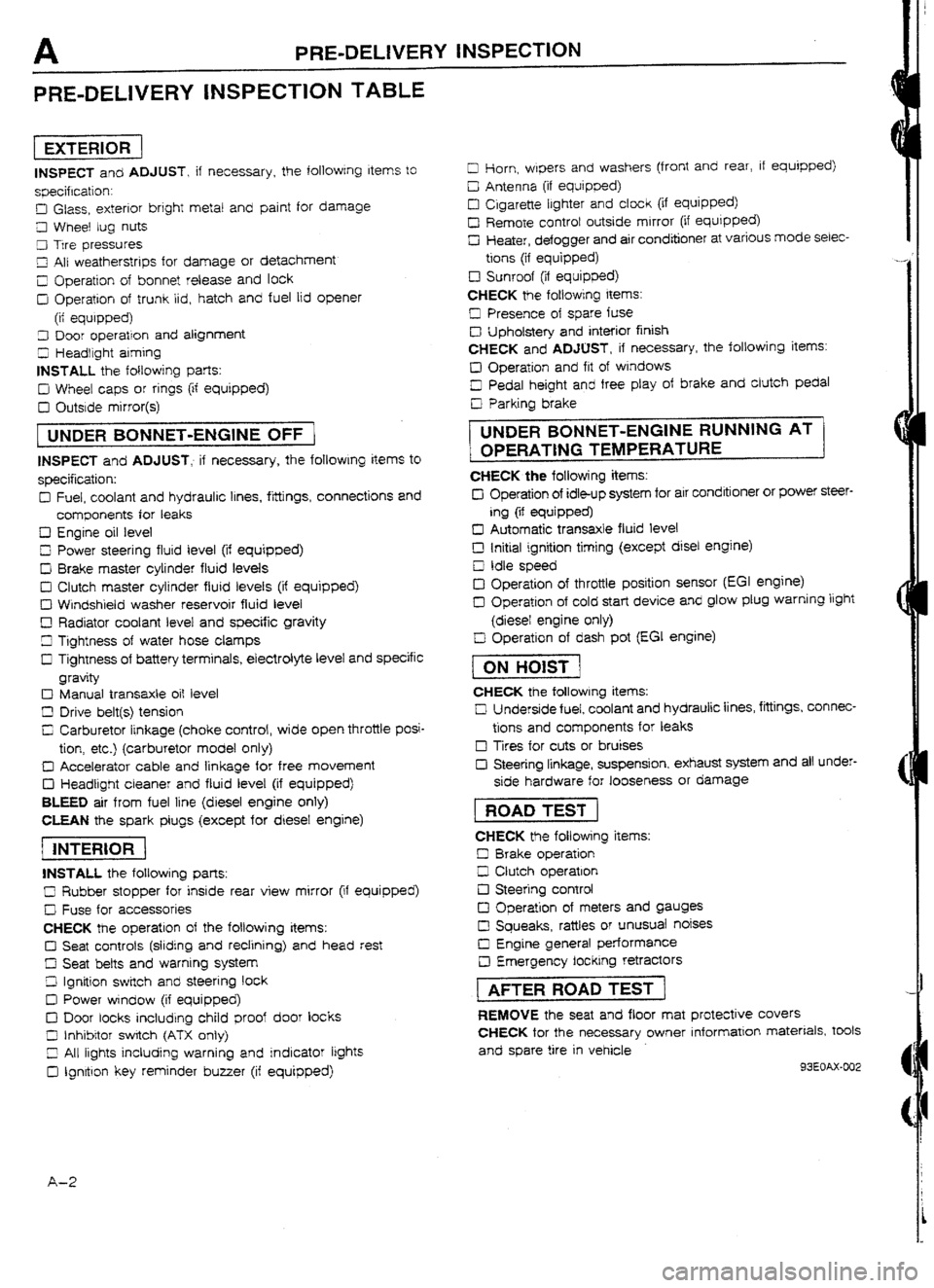
A PRE-DELIVERY INSPECTION
PRE-DELIVERY INSPECTION TABLE
pieziG-
INSPECT and ADJUST, if necessary, the following Items to
specification:
D Glass, exterior bright metal and paint for damage
Cl Wheel tug nuts
9 Trre pressures
LII All weatherstrips for damage or detachment
Z Operation of bonnet release and lock
D Operation of trunk lid, hatch and fuel lid opener
(it equipped)
3 Door operation and alignment
5 Headlight aiming
INSTALL the following parts:
D Wheel caps or rings (if equipped)
D Outside mirror(s)
[ UNDER BONNET-ENGINE OFF )
INSPECT and ADJUST, if necessary, the foIlowIng items to
specification:
Cl Fuel, coolant and hydraulrc lines, fittings, connections and
components for leaks
Cl Engine oil level
0 Power steering fluid level (if equipped)
D Brake master cylinder fluid levels
0 Clutch master cylinder fluid levels (if equipped) q
Windshield washer reservoir fluid level
D Radiator coolant level and specific gravity
Ll Tightness of water hose clamps
I3 Tightness of battery terminals, electrolyte level and specific
gravity
c) Manual transaxle oit level
D Drive belt(s) tension
C; Carburetor linkage (choke control, wide open throttle posi-
tion, etc.) (carburetor model only)
D Accelerator cable and linkage for free movement
D Headlight cleaner and fluid level (if equipped)
BLEED air from fuel line (diesel engine only)
CLEAN the spark plugs (except for diesef engine)
piicis-1
INSTALL the foflowing parts:
C Rubber stopper for inside rear view mirror (if equipped)
c! Fuse for accessories
CHECK the operation of the following items:
Cl Seat controls (sliding and redining) and head rest
ci Seat belts and warnrng system
Z! Ignition swrtch and steering lock
III Power window {if equipped)
0 Door locks including child proof door locks
0 Inhibitor switch
(ATX only)
Z All lights including warning and indicator lights
0 Ignrtron key reminder buyer (if equipped) Cl Horn, wipers and washers (front and rear, if equipped)
D Antenna (if equipped} q
Cigarette lighter and clock (if equipped)
I2 Remote controt outside mirror
(if equipped) q
Heater, defogger and air conditioner at various mode selec-
tions (if equipped)
c3 Sunroof (if equipped)
CHECK
the fotiowing items: q
Presence of spare fuse
c3 Upholstery and interior finish
CHECK and ADJUST, if necessary, the following items:
Cl Operation and fit of windows
D Pedal height and free ptay of brake and clutch pedal
Cl Parking brake
i UNDER BONNET-ENGtNE RUNNING AT ]
1 OPERATtNG TEMPERATURE
CHECK the following items:
Cl Operation of idle-up system for air conditioner or power steer-
ing (if equipped)
13 Automatic transaxle fluid level
D Initial ignition timing
(except disel engine) q
Idle speed
El Operation of throttle position sensor (EGI engine)
13 Operation of cold start device and glow plug warning light
(diesel engine only)
D Operation of dash pot [EGI engine)
t
ON HOtST 1
CHECK the following items:
U Underside fuel, coolant and hydraulic lines, fittings, connec-
tions and components for leaks q
Tires for cuts or bruises
Cl Steering linkage, suspension, exhaust system and all under-
side hardware for
looseness or damage
1 ROAD TEST 1
CHECK the foliowing items:
II Brake operation
D Clutch operation
0 Steering control
c3 Operation of meters and gauges
0 Squeaks, rattles or unusual noises q
Engine general performance
c3 Emergency Iocking retractors
rAFTER ROAD TEST 1
REMOVE the seat and floor mat protective covers
CHECK for the necessary
owner information materials, tools
and spare tire in vehicle
93EOAX-002
A-2
Page 22 of 677
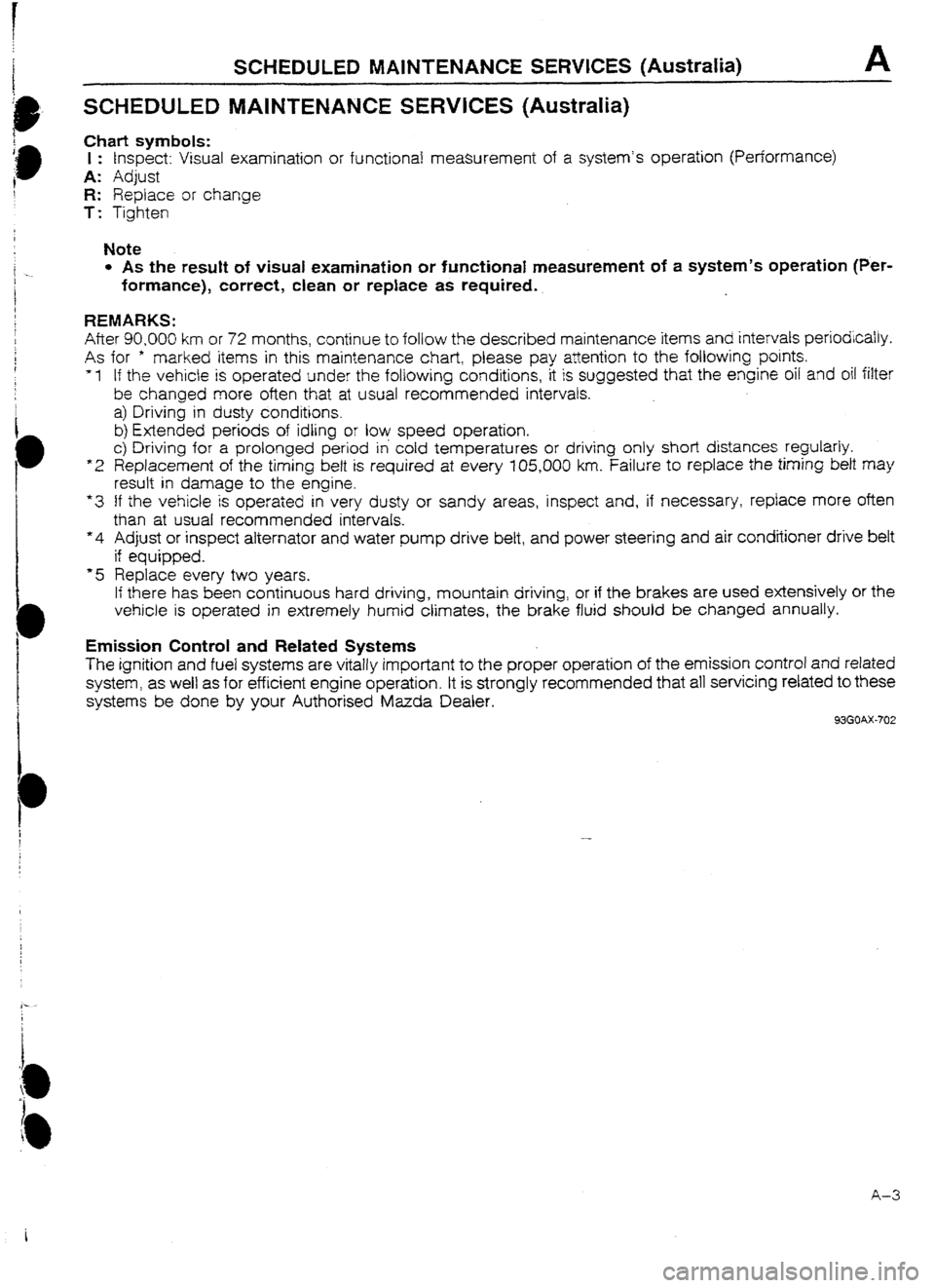
SCHEDULED MAINTENANCE SERVICES (Australia) A
SCHEDULED MAINTENANCE SERVICES (Australia)
Chart symbols:
I : Inspect: Visual examination or functiona! measurement of a system’s operation (Performance)
A: Adjust
R: Replace or change
T : Tighten
Note
l As the result of visual examination or functional measurement of a system’s operation (Per-
formance), correct, clean or replace as required.
REMARKS:
After 90,000 km or 72 months, continue to follow
the described maintenance items and intervals periodically.
As
“I
*2
*3
“4
l 5 for *
marked items in this maintenance chart please pay attention to the following points.
If the vehicfe is operated under the foltowing conditions, it is suggested that
the engine oil and oil f&r
be changed more often that at usual recommended intervals.
a> Driving in dusty condrt,ons.
b) Extended periods of idling
or low speed operation.
c) Driving for a prolonged period iti coid temperatures or driving only short distances regularly.
Replacement of the timing belt is required at every 105,000 km. failure to replace the timing belt may
result in damage to the engine.
If the vehicle is operated in very dusty or sandy areas, inspect and, if necessary, repface more often
than at usual recommended intervals.
Adjust or inspect alternator and water pump drive belt, and power steering and air conditioner drive belt
if equipped.
Replace every two years.
If there has been continuous hard driving, mountain driving, or if the brakes are used extensively or the
vehicle is operated in extremely humid climates, the brake fluid shotlid be changed annually.
Emission Control and Related Systems
The ignition and fuel systems are vitally important to the proper operation of the emission control and related
system, as well as for efficient engine operation. It is strongly recommended that all servicing related to these
systems be done by your Authorised Mazda Dealer.
93GOAX-702
-
A-3 i
Page 23 of 677
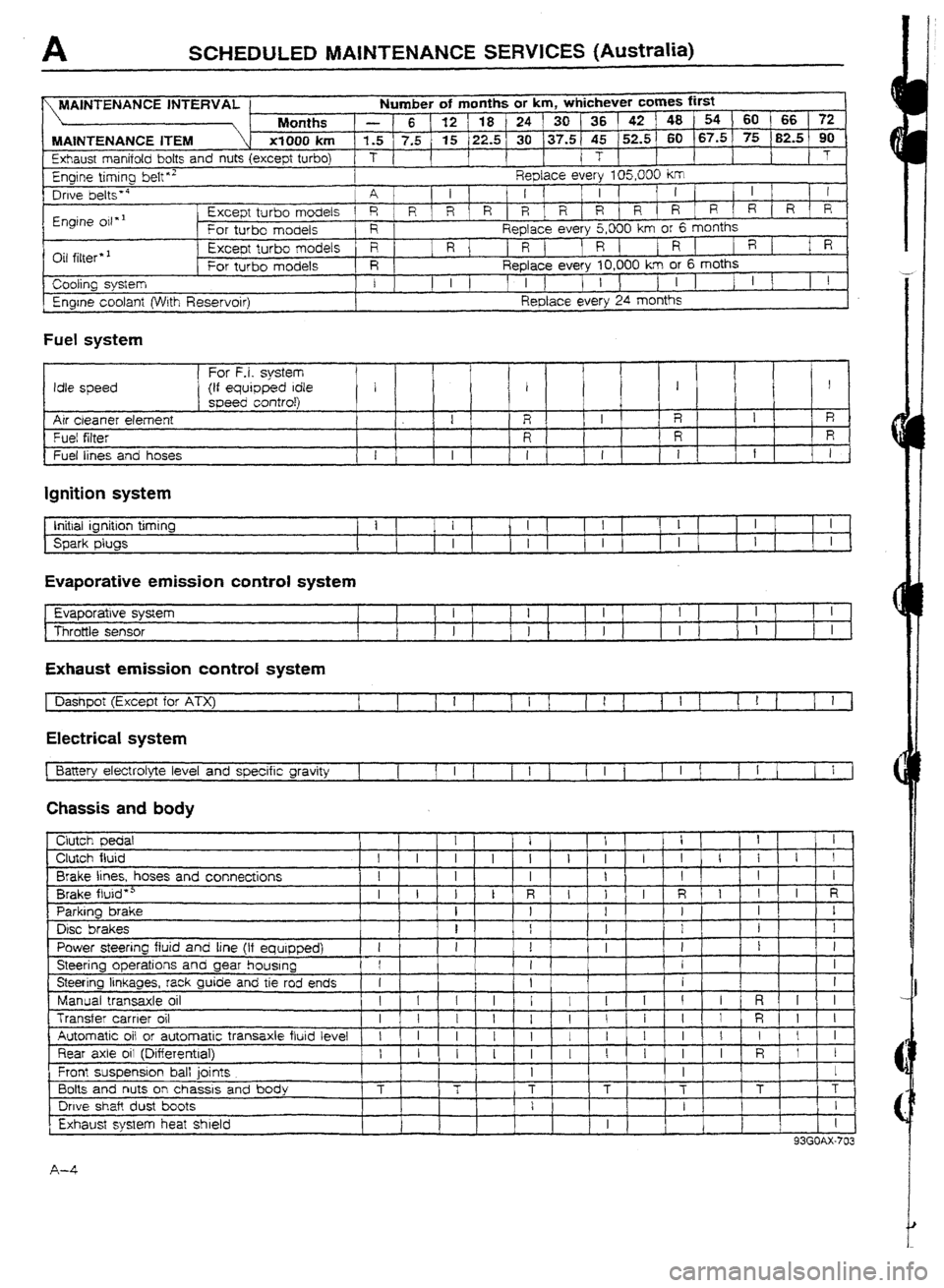
A SCHEDULED MAINTENANCE SERVICES (Australia)
lumber of months or km, whichever cumes first
P
_ 48 54 60 1 66 72
5
60 67.5 75 90 .--- .-- -
.-m-w --v-w _ _ -_-- - - _ _ - -
_ -- - - --- __-
_-
-- -- (82.5
Exhaust manifold bolts and nuts (except turbo) T 1
I i T 1
1 T
Engine timlrtg belt”’ Replace every 105,000 km
Drwe belts * a
A I 1 I 1 1 I 1
! ’ I I 1 1
Engine oil * ’ Except turbo models 1 RIR\R/RIRIRIR R R,R R R/R
For turbo models R
Replace every 5,000 km or 6 months
r-k:1 c:t+*-* 1 Except turbo models
R 1 R 1 1 R ( ) R ( 1 R ( 1
R 1 f R
-
1 VII IIIIc;I 1 For turbo models I R 1 ReDlace everv IO.000 km or E
Engine coolant (Wrth Reservoir)
Fuel
system
Replace e&y 24 months
For F-i. system
Idle speed (if equipped Idle 1 1 1 I
I speed controf)
Air cleaner element 1
R , I R I R
Fuet filter
I I? R R
~ Fuel lines and hoses
1 I 1 I I 1 I I 1 1
Ignition system
t Initial ignition timing
Spark plugs i I I I -1 I I
I I I I I
f
Evaporative emission control system
Evaporative system
Throttle sensor
Exhaust emission contra! system
[ Dashpot
(Except for ATX) I 1 I
1 1 I 1 1 t 1 1 1 1 1 ! 1 1 I 1
Electrical system
Battery electrolyte level and specific gravity ]
I 1 1 I 1 t I ’ 1 1 I 1 f I ( 1
I 1
Chassis and body
Brake lines, hoses and connections
Brake fluid * a
Parking brake
Disc brakes
1 Power steering fluid and line Ilf &uiDDedl
I 1 1 I I I
I 1 1 III II
I ’
I I
Steering operations and gear housing
I
1 1 I --r--j- 1 I
I
Steerino linkanes. rack auide and tie rod pnds .-- --
----.“.a ..‘-~--, J- -.-- _.- .-- -..-- I I I t I 1 1 I I I I I I I 1
Manual transaxle oil I \\!‘I rl\jl I 1 I R III
1 Transfer Automatic carrier oil or 09 automatic transaxle fluid level
1 1 I 1 111 I 1 I l 1 I 1 I 1[11i t I 1 I 1 I I 1 I
R 1 Iii 1 I
1 Rear axle oil (Differential) 1 t I I I I I I I I
t ’ I r . ’ 1 . I I I I I R I 1
I
I I
i T
1 T T T 1 T [ T I 1 T
Front suspension ball joints
Bolts and nuts on chassis and body
I I I . I ! ,
I 1 I . I 1 ’ I I ’
Drive shaft dust boots
I
I 1 I 1
I 1 1 I
~~
- - ’ C1utcl-1 pedat
Clutch fluid
1
A-4
Page 24 of 677
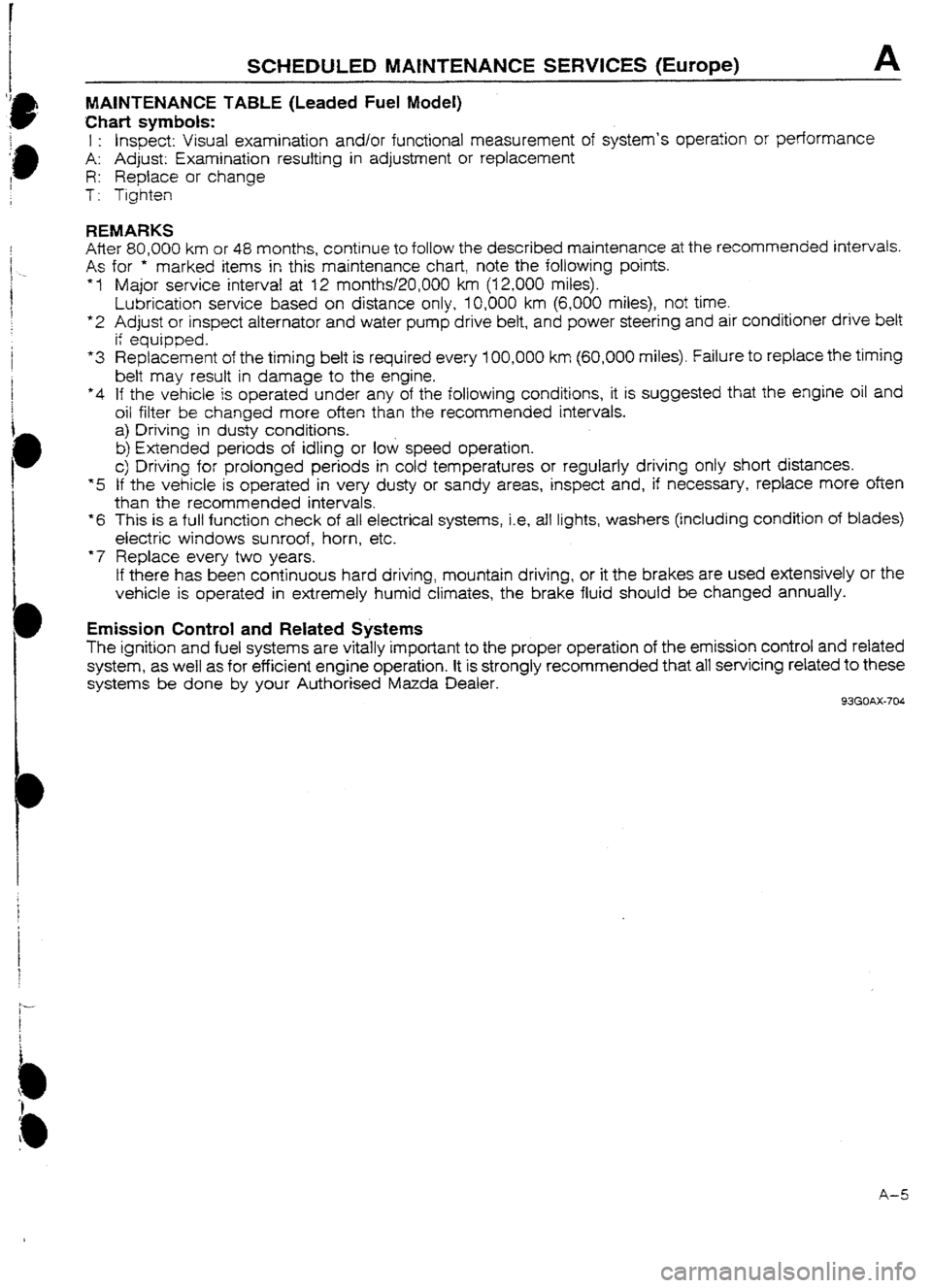
!
i
i
I
i
t-
I
i
i
e
-1
SCHEDULED MAfNTENANCE SERVICES (Europe) A
MAINTENANCE TABLE (Leaded Fuel Model)
Chart symbols:
1 : Inspect: Visual examination and/or functional measurement of system’s operation or performance
A: Adjust: Examination resulting in adjustment or replacement
R: Replace or change
T: Tighten
REMARKS
After 80.000 km or 48 months, continue to foltow the described maintenance at the recommended intervals.
As
*I
*2
“3
*4
*5
*6
*7 for *’
marked items in this’ maintenance chart, note the following points.
Major service interval at 12 months!ZO,OOO km (I 2,000 miles).
Lubrication service based on distance only, 10,000 km (6,000 miles), not time.
Adjust or inspect alternator and water pump drive belt, and power steering and air conditioner drive belt
ii equipped.
Replacement of the timing belt is required every ICQOUO km (60,000 miles). Failure to replace the timing
belt may result in damage to the engine.
If the vehicle is operated under any of the following conditions, it is suggested that the engine
oil and
oil filter be changed more often than the recommended intervals.
a) Driving in dusty conditions.
b) Extended periods of idling or low speed operation.
c) Driving for prolonged periods in cold temperatures or regularly driving only short distances.
If the vehicle is operated in very dusty or sandy areas, inspect and, if necessary, replace more often
than the recommended intervals.
This is a full function check of all electrical systems, i.e, afl lights, washers (inctuding condition of blades)
electric windows sunroof, horn, etc.
Replace every two years.
tf there has been continuous hard driving, mountain driving, or it the brakes are used extensively or the
vehicle is operated in extremely humid climates, the brake fluid should be changed annually.
Emission Control and Related Systems
The ignition and fuel systems are vitally important to the proper operation of the emission control and related
system, as well as for efficient engine operation. It is strongly recommended that all servicing related to these
systems be done by your Authorised Mazda Dealer.
93GOAX-704
A-5
Page 25 of 677
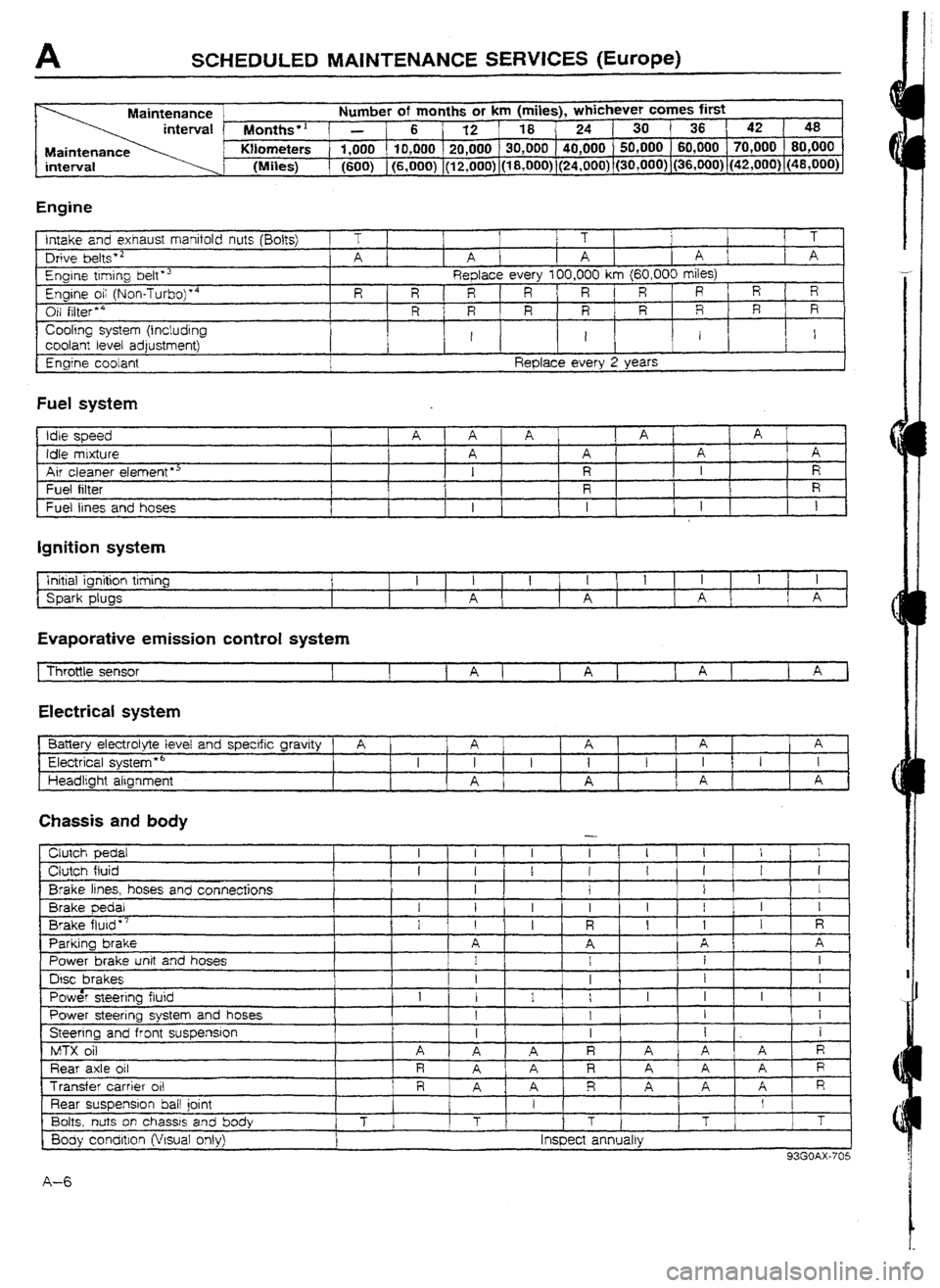
SCHEDULED MAlNTENANCE SERVICES (Europe)
Maintenance Number of months or km (miles), whichever comes first
Months” - 6 1 12 18 24 1 30
36 1 42 48
Maintenance Wometers 1,000 10,000 20,000 30,000 40,000 50,000 60,000 1 70,000 80,000
interval
(Miles) (600) (6,000) (12,000) (18,000) (24,000) (30,000) (36,000)~(42,000) (48,000)
Engine Intake
and exhaust manifold nuts (Bolts) Drive belts * 2
Engine ttming belt *’
Engine oi; (Non-Turboj’4
Oil filter * 4
Cooling system (Including coolant
level adjustment)
Enaine coolant T
1 1 1
1 1 ’
A
[ A I A 1 A ] [ A
Replace every t 00,000 km (60,000 miles)
R
R R R R R R R 1 R
R R R R R R R R
I I 1 I
Reolace everv 2 Years
Fuel system
Idle speed
Idle mixture
Air cleaner element *’ Fuel
filter
Fuel lines and hoses
I A I * A 1 A 1 A
I
A A A A
I R I R
R
I R I
1 I
t I 1 [ I
Ignition system
Initial ignition timing
Spark plugs I t I I 1 I 1 I
A A ( A A
Evaporative emission control system
Electrical system
Ejattery electrolyte level and specific gravity A
A 1 A A 1 A
Electrical system
l 6
I I I
I t I 1 I I
Headlight algnment
A A f A 1 A
Chassis and body
Clutch pedal
Clutch fluid
Brake lines, hoses and connections
Brake pedal
Brake flutd *7
Parking brake
Power brake unit and hoses
DGC brakes
Pow& steering fluid
Power steering system and hoses
Steering and front suspension
MTX oil
Rear axle oil
Transfer carrier
ui!
Rear suspension bail joint
Bolts, nuts on chassis and body
8ody condltlon (Visual onty)
-
I I I I I I I I
1 I I I I I I I
I
1 I I
i
1 I I I I I I
I I I
R I 1 I R
A A A 1 A
1
1 i 1 I
I
I I
I
I
I I I I I I I
I 1 I I
I 1 I 1 i
1 A
A R A A A R
iR,i A R A A A R
R ’
A . A R A A A R
f I
T
T T T
T
I Inspect annually
93GOAX-705
A-6